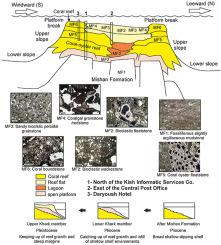Journal of African Earth Sciences ( IF 2.2 ) Pub Date : 2021-06-26 , DOI: 10.1016/j.jafrearsci.2021.104316 Parisa Gholami Zadeh , Alireza Shafeii

|
Plio-Pleistocene period in the Persian Gulf, Iran was marked by the development of carbonate rocks of the Khark Formation. The shallow-water carbonates of the Khark Formation record fluctuations in sea-level. Khark limestones unconformably cover the calcareous marlstones of the Late Miocene Mishan Formation. This study used petrographic analysis and SEM-EDX analysis to determine microfacies, diagenetic products, sedimentary environments, sedimentary cycles, and relative sea-level changes during the Plio-Pleistocene. Based on the textural features and fossil content, six microfacies were recognized in the lagoon, shoal, back reef, and reef facies belts. The dominance of reef and grainstone facies shows a high-energy shallow-marine environment and the existence of a paleo-high. This paleo-high was formed due to the Late Pliocene deformation and folding in the Persian Gulf. The Khark carbonates were deposited as a reef complex on an anticline parallel to the Zagros Orogeny trend due to dominance of reef and grainstone facies, variable thickness, and irregular pre-existing topography during the Zagros folding phase. Morphology of cement crystals, the spatial distribution of cement, and their compositional variations display that the Low-Mg dogtooth calcite, gypsum cement, and moldic porosity were formed in the sandy bioclastic peloidal grainstone facies with meteoric diagenesis during the relative sea-level fall, whereas aragonite isopachous fringe of cement and High-Mg calcite (beachrocks) were developed in the reefal facies with marine phreatic diagenesis during relative sea-level rise. Khark Formation consists of two shallowing upward sequences that were marked by coral boundstone and oyster-coral floatstone facies during sea-level Highstand at the top. These facies changes are in close agreement with the local sea-level changes curve during Plio-Pleistocene in the Persian Gulf. This kind of study can improve our understanding of reservoir characterization of the reefal carbonates in the subsurface sections.
中文翻译:

波斯湾基什岛上新世-更新世碳酸盐沉积对相对海平面变化的响应
伊朗波斯湾的上新世-更新世时期的标志是Khark组碳酸盐岩的发育。Khark 组的浅水碳酸盐记录了海平面的波动。哈尔克灰岩不整合地覆盖在晚中新世密山组的钙质泥灰岩上。本研究使用岩相分析和 SEM-EDX 分析来确定上新世期间的微相、成岩产物、沉积环境、沉积旋回和相对海平面变化。根据构造特征和化石含量,在泻湖、浅滩、背礁和礁相带中识别出6个微相。礁、粒岩相占优势,显示为高能浅海环境,古高地存在。这个古高地是由于波斯湾的上新世晚期变形和折叠而形成的。由于珊瑚礁和颗粒岩相占优势,厚度可变,以及在 Zagros 折叠阶段不规则的预先存在的地形,Khark 碳酸盐岩沉积为与 Zagros 造山运动趋势平行的背斜上的珊瑚礁复合体。胶结物晶体形态、胶结物空间分布及其成分变化表明,在相对海平面下降过程中,在风化成岩作用的砂质生物碎屑球状颗粒岩相中形成了低镁犬齿方解石、石膏胶结物和铸模孔隙,而在海平面相对上升的海相潜水成岩的礁岩相中,发育了胶结物和高镁方解石(海滩岩)的文石等厚边缘。Khark 组由两个浅层向上层序组成,在顶部的海平面高位期间以珊瑚边界岩和牡蛎珊瑚浮岩相为标志。这些相变化与波斯湾上新世-更新世局部海平面变化曲线非常吻合。这种研究可以提高我们对地下部分珊瑚礁碳酸盐岩储层特征的理解。











































 京公网安备 11010802027423号
京公网安备 11010802027423号